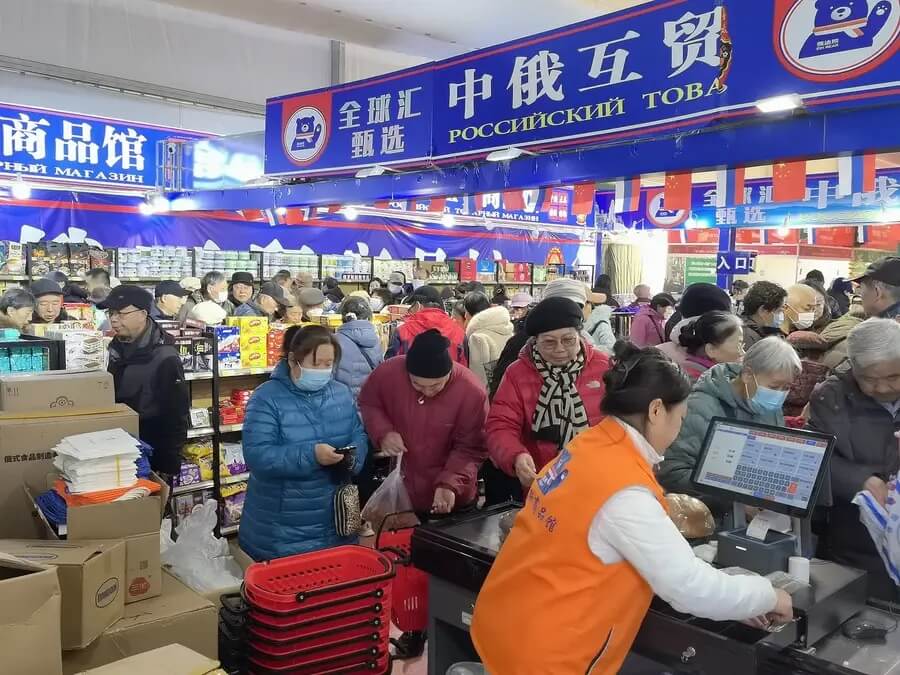World Geostrategic Insights interview with Tatiana Pokrovskaia on the reasons behind the boom in trade between Russia and China, the spread of Russian retail businesses in China, and growing turnover in the agri-food sector.

Tatiana Pokrovskaia is an international business development professional with more than 20 years of experience in the markets of Africa, CIS, Asia and the Middle East, repeatedly bringing Russian companies into international markets. She is based in St. Petersburg, Russia.
Q1 – Trade between China and Russia reached a record high of €240 billion in 2024, an increase of 2% over the previous year. Although lower than the previous year’s growth (26.3%), this rise highlights the continued strengthening of the economic partnership between the two nations. What is your opinion on the impressive increase in trade between Russia and China in recent years? Is this a reaction, a change in trade dynamics due to external pressures, such as Western sanctions on Russia and growing trade tensions between the US and China? Or is it the natural result of a strong economic interdependence between Russia and China?
A1 – As stated in the joint statement of the Russian Federation and China, Russia and China are deepening cooperation on maintaining and strengthening global strategic stability and countering common threats. According to the statement, published on the Kremlin website, the parties are convinced that progress in these areas would significantly improve the situation in the field of international security, as well as support strategic stability in the world.
Cooperation between the two powers is not only economic in nature, but also contributes to solving security problems in the Middle East, Afghanistan, the Korean Peninsula and other regions.
On May 8, 2025, an updated agreement was signed between the Russian Federation and the People’s Republic of China(PRC) on the promotion and mutual protection of investments. As noted by the Russian Ministry of Economic Development, “One of the priority areas of work for Russian investors in China is the production of rolled products from high-tech aluminum alloys. In addition, Russian companies see prospects in implementing projects in the field of insurance, infrastructure construction, metallurgy and others.”
Growing external pressure on both countries is pushing for even greater unification, mutual investment and economic cooperation. China remains one of the key destinations for Russian exports due to its large market and growing demand for Russian products. This is not only sales, but also the implementation of joint projects in many areas.
Following the talks in the Kremlin on May 8, 2025, both sides signed more than 20 documents in various areas of cooperation, including international law and security, investment protection, digital economy, and cooperation in the field of cinema, as well as quarantine control and others.
Q2 – Russian supermarket chains are booming in China, and temporary stores specializing in Russian products have also become increasingly common, driven by growing Chinese consumer interest in Russian products and widespread Russophilia. In fact, in addition to the positive reception of Russian products by Chinese consumers, the growing sense of affinity among the Chinese population towards Russia is fostering closer cultural ties between the two nations, as evidenced by the increase in tourist flows between the two countries. What is your opinion on the spread of Russian retail businesses in China and their prospects?
A2 – The strengthening of cooperation between the two countries has led to a high growth of interest in Russian products and culture. The Chinese like the taste of Russian foods, confectionery, honey, chocolate, vodka, “condensed milk with sugar” (this is a favorite Russian dessert since Soviet times). and others. They rate Russian products as more natural and of higher quality.
In recent years, thousands of stores with Russian food products have opened throughout China, as a result of the sympathy of the Chinese public for Russia and the deepening of trade ties between Beijing and Moscow.
According to Chinese statistics, since 2022, more than 2,500 new companies have been registered to trade in Russian goods, and mostly were registered in the last year alone. Most of the companies are located in the north of the country, since the supply of Russian products is mainly carried out by rail through the northern regions.
However, against the backdrop of the excitement over Russian food products in China, unfortunately, the number of counterfeits of Russian goods has increased.
While in China, we repeatedly saw Russian names of products with obvious grammatical errors on the shelves or goods that are prohibited from being imported into the country. For example, for some time the import of sausages from the Russian Federation to China was prohibited to support the national producer.
Nevertheless, the growth prospects of the Russian retail business in China are great against the background of strengthening cooperation between the countries and growing demand for Russian products. This is also facilitated by the official support of Russian government agencies, such as the Russian Export Center (REC), to the organization of the “Made in Russia” Festivals, and opening of Russian Agro-Industrial Complex Pavilions, and Russian stores, throughout China. By the end of the year, the REC plans to open up to 300 stores of Russian goods, together with Chinese partners, across the country.
Q3 – In 2024, Russia’s agricultural exports to China exceeded 8.3 million tons, worth approximately $7.4 billion, with a significant increase in trade between the two countries compared to previous years. China is now the main importer of Russian agricultural products, and the Chinese government is also actively investing in the Russian agricultural sector, with 255 joint projects worth over $11 billion and planned investments for 2024 amounting to $170 million, focusing on crops such as soybeans and corn and greenhouse vegetable cultivation. In addition, Russia has become a key supplier of meat to China, including pork and turkey, while fish exports to China have reached almost 1.5 million tons, worth over $2 billion. The two countries are also strengthening ties in the dairy sector, taking advantage of booming dairy consumption in China and Russia’s high production capacity. What is your opinion on the prospects for the development of trade between Russia and China in the agricultural and food sector?
A3 – You are right, the turnover in the food sector between China and Russia is growing. And China is investing in the development of the agricultural sector of the Russian Federation. As I mentioned above, considering Russian products to be more natural and healthy.
China is the largest food market with a consumption volume of about $ 2 trillion per year. According to official statistics, by 2030, the consumption of agricultural products in China will increase by 40% due to population growth and rising welfare.
Milk was not genetically part of the Chinese national cuisine. And only in the 70s of the 20th century did a milk boom begin in China, after economic reforms that opened the country to the international market and the private sector. Nevertheless, concern for the population and awareness of the usefulness of milk and dairy products contribute to the growth of consumption, which can be helped by Russian exports.
Russia has ample opportunities for export to China due to its production capabilities and geographical location. In accordance with the Agreement on Cooperation in Agriculture between Russia and China, signed in 2018, the most important areas of cooperation are designated – supplies of grain, meat, fish and dairy products. China is the largest importer of Russian grain.
Russia occupies a leading position in the amount of unused agricultural land and its development, which is an advantage in production and export and allows it to meet the growing demand for food products in China, while maintaining food security for both countries.
Q4 – The structure of Russian exports is evolving and diversifying the products exported. In this context, there has been significant growth in exports of confectionery products, particularly chocolate, making Russia China’s main supplier. Exports of products such as ice cream, canned foods, and honey to China are also on the rise. What is your opinion on the prospects for cooperation between the two countries in the specific sector of the confectionery industry?
A4 – As I stated previously, Russian confectionery products are very popular with the Chinese. Which, of course, makes Russia the main supplier to China, in the framework of the growing ties between peoples. The advantage of Russian products is the naturalness of the ingredients, taste.
According to Agroexport of the Russian Federation, in 2024, the total export of Russian chocolate products amounted to almost $ 850 million, showing an increase of 8% compared to the previous year., supplying chocolate to 90 countries of the world. Moreover, each of these countries is increasing exports, noting the high quality of Russian chocolate.
Last year, China entered the top three largest importers of chocolate, increasing the cost of purchases of Russian chocolate products by 24%. However, one should take into account the Asian culture of gift giving. Therefore, the growth of chocolate consumption in China occurs in the winter months. Seasonality of confectionery consumption is also noted. In the summer – marmalade and caramel, in the colder months – nuts, nougat. Nevertheless, the Chinese like the taste of Russian confectionery products. Interest in cookies with creamy flavors and flour products is growing. Russian honey is highly valued by the Chinese because of its naturalness. It is known that China is currently the leader in honey consumption in the world.
Growing cooperation between the countries, as well as the high loyalty of the Chinese to Russia, Russian cuisine, and culture makes Russia the main supplier in many sectors. Especially those that were not traditional for export – the food industry and confectionery.
In recent years, government agencies of the Russian Federation, such as the Russian Export Center, have been introducing non-traditional products to the international market, introducing China and other countries to Russian tastes, cuisine, and culture.
Russia is opening up from a different side, not only as a supplier of energy resources and weapons, but as a multinational, culturally rich country, whose cuisine is capable of making various regions fall in love with it, reflecting its diversity and variety.
I am optimistic about the cooperation between the two countries, and I think that we still have something to surprise our neighbors with.
Tatiana Pokrovskaia – International business development professional.
Image Source: theworldofchinese.com







